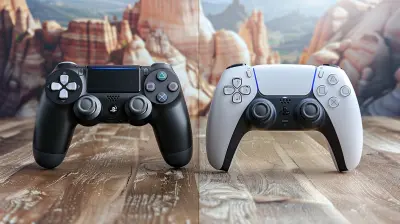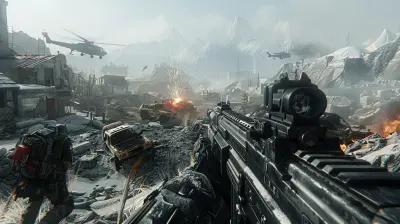Breaking the Boundaries: How Puzzle Solving Fits into Sandbox Games
29 June 2025
When you think of sandbox games, what springs to mind? Massive open worlds? Endless freedom? Building and shaping anything your imagination can muster? Sure, those are core elements, but there’s another layer to these games that’s been quietly making waves: the integration of puzzle-solving mechanics. Let’s dive in and unravel (pun intended) how puzzles breathe new life into these expansive, open-ended worlds.

What Makes Sandbox Games So Special?
Sandbox games are like the playgrounds of the gaming world. They hand over the keys and say, “Go wild.” You decide how to play, when to play, and why to play. There are no rigid storylines forcing you down a particular path. Whether you’re terraforming landscapes in Minecraft, exploring distant planets in No Man’s Sky, or wreaking havoc in GTA V, sandbox games allow you to, quite literally, play your way.But here’s the kicker: with all this freedom, there’s a natural craving for structure. Odd, right? You’d think people would just lean into the limitless creativity, but humans are wired to love challenges. That’s where puzzle-solving comes in. It’s the perfect way to add depth and dynamism to an otherwise boundless experience.

How Puzzle Solving Complements Sandbox Gameplay
Let’s break things down. At first glance, puzzles and sandbox worlds seem like polar opposites. One is structured and demands you follow specific rules, while the other is all about throwing the rulebook out the window. But that’s precisely what makes their union so satisfying. It’s like peanut butter and jelly—you wouldn’t think they’d work, but once you try it, you can’t imagine them apart.Puzzles provide a sense of purpose in sandbox games. They give you something to work toward, a reason to pause your exploration and think critically. They’re those “Aha!” moments in a sea of endless possibilities. Whether they’re woven into the world’s lore or just a quirky side quest, puzzles bring balance to the chaos.
The Appeal of Puzzle Solving in Open Worlds
Let’s be real—solving a good puzzle is ridiculously satisfying. When you finally crack that tricky code, shift that last block into place, or decipher a riddle’s hidden meaning, it’s pure dopamine. It’s not just about figuring something out; it’s about feeling clever, resourceful, and, let’s admit it, a little smug.Sandbox games use this to their advantage. By sprinkling puzzles throughout their sprawling environments, they keep things fresh. You’re not just wandering aimlessly or completing repetitive tasks—you’re actively engaging your brain.
And the best part? Sandbox puzzles usually let you approach them your way. Found a puzzle at the bottom of a lake? Maybe you build a bridge to reach it or dive headfirst with scuba gear. The solutions aren’t always handed to you on a silver platter, and that’s where the magic happens. It’s about creativity, persistence, and sometimes thinking way outside the box.

Games That Nail the Puzzle-Sandbox Combo
Some games just get it, you know? They seamlessly blend puzzle mechanics into their sandbox design, creating experiences that stick with you long after you log off. Here are a few standout examples:1. The Legend of Zelda: Breath of the Wild
Okay, this one’s a no-brainer. The game is a masterpiece of marrying puzzle-solving with an open world. The Shrines scattered across Hyrule? Pure genius. Each one is a compact puzzle playground, asking you to think strategically about physics, elemental interactions, and sometimes just plain old logic. And the kicker? There’s usually more than one way to solve them.You might use a bomb to blow something up, or, if you’re particularly cheeky, try exploiting game mechanics to create a shortcut. The freedom makes every solution feel like it’s truly yours.
2. Minecraft
Minecraft isn’t just about building dirt huts (although, hey, no shame if that’s your vibe). The game’s Redstone system is essentially a giant sandbox puzzle within a sandbox game. Players can create everything from simple doors to elaborate contraptions, like working calculators or even in-game computers.The beauty here is that the game doesn’t explicitly tell you how to use Redstone. You figure it out through experimentation, trial-and-error, and maybe a few late-night YouTube binges. It’s rewarding, addictive, and completely unique to each player.
3. Portal Knights
This gem takes a more structured approach to sandbox gaming but still manages to weave in some brilliant puzzles. As you hop between islands, you’ll encounter puzzle-filled dungeons that stand out against the game’s colorful, blocky world. It’s a blend of exploration and intellectual challenge that keeps things interesting.4. No Man’s Sky
At first glance, No Man’s Sky might seem like pure exploration, but there’s plenty of puzzle-solving woven into its vast universe. From deciphering alien languages to unraveling the secrets of ancient ruins, the game constantly nudges you to explore more deeply.5. Rust
A survival sandbox game with a twist. While most people associate Rust with gathering resources and avoiding rival players, the addition of puzzles (like the Monument puzzles) adds a layer of complexity. Solve them, and you’ll unlock hidden areas loaded with loot. They’re high-risk, high-reward challenges that can make or break your survival strategy.Why Puzzles Work So Well in These Games
So, what makes puzzles click in sandbox games? A few things come to mind:1. They Break Up the Grind
Let’s face it—sandbox games can get repetitive. You gather, craft, explore, rinse, and repeat. Puzzles shake things up, giving you a breather from the grind.2. They Encourage Exploration
Puzzles are often tucked away in the game’s nooks and crannies, pushing you to explore areas you might otherwise overlook. They reward curiosity, making every corner of the map feel worth investigating.3. They Challenge Your Thinking
Sandbox games flex your creative muscles, but puzzles engage your critical thinking. It’s the best of both worlds.4. They Offer a Sense of Accomplishment
Sure, building a massive castle or taming a dinosaur is cool, but there’s something uniquely satisfying about solving a tricky puzzle.
The Future of Puzzles in Sandbox Games
As games continue to evolve, the line between sandbox and puzzle games will likely blur further. Developers are finding new ways to integrate brain-teasers into open worlds, creating richer, more diverse experiences.Imagine a sandbox game with puzzles so intricate, they change based on your decisions. Or maybe one where your solutions become part of the world’s narrative. The possibilities are endless, and, honestly? I can’t wait to see where this trend goes.
Whether you’re a casual player or a hardcore gamer, one thing’s certain: puzzles make sandbox games better. They add depth, challenge, and a refreshing change of pace. So, next time you’re wandering through your favorite open-world game, keep an eye out for those brain-bending challenges. They’re worth it.
all images in this post were generated using AI tools
Category:
Sandbox GamesAuthor:

Pascal Jennings
Discussion
rate this article
1 comments
Soraya Reynolds
Puzzle-solving enriches sandbox games, enhancing creativity and engagement.
July 14, 2025 at 4:29 PM

Pascal Jennings
Thank you! I completely agree—integrating puzzles not only boosts player creativity but also deepens their overall engagement in sandbox environments.


